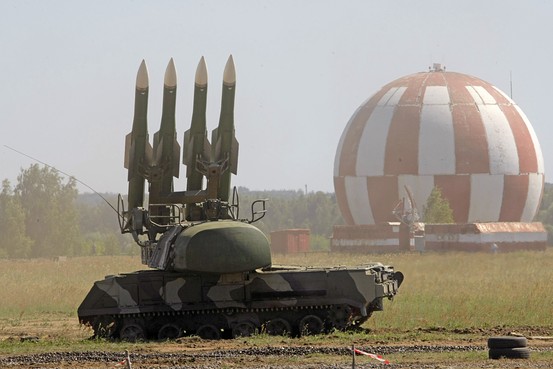The disclosure deepens the mystery of why Ukrainian aviation officials failed to entirely close off the airspace in the Donetsk region, where the jet was flying went it was shot down, killing all 298 people on board.
Three Buk-M1 medium-range antiaircraft systems, also known as the SA-11 Gadfly under the North Atlantic Treaty Organization designation, were known to be in rebel hands as early as July 14, said Vitaly Nayda, the head of the counterintelligence division of Ukraine's security service.
Ukraine imposed a partial flight ban in the region on flights below 26,000 feet on July 1, and raised the ceiling of the exclusion area to 32,000 feet on July 14. The Malaysia Airlines plane was flying at 33,000 feet.
The altitude restrictions on commercial flights were raised after rebel separatists backed by Moscow on July 14 shot down a Ukrainian military Antonov An-26 transport plane with eight people on board over the skies of the Luhansk region. The aircraft was flying at 21,000 feet.
"I can't think of any reason why you would increase a restriction to 32,000 feet when the bad boys have just demonstrated a capability to go all the way," said a European aviation safety veteran. The airspace should have been closed, he said.
Comment: Really? 'Bad boys'?
Mr. Nayda said the Ukrainian security service lacks hard evidence that the AN-26 was shot down by a Buk system, though it was clear that a surface-to-air missile of some sort was responsible. More ubiquitous shoulder-fired, heat-seeking ground-to-air missiles that are viewed as a more common threat to aircraft wouldn't have been capable of reaching the altitude at which the military plane was flying. The incident is being investigated.
Malaysian Transport Minister Liow Tiong Lai on Saturday rejected accusations that the country's national airline was reckless in allowing Flight 17 to fly over the conflict zone.
"MH17's flight path was a busy major airway," he said. "It flew at an altitude set, and deemed safe, by the local air traffic control. And it never strayed into restricted airspace."
Ukrainian officials have now entirely closed off the airspace in that region of the country.
The skies over eastern Ukraine ordinarily serve as a major artery of global air travel, linking flights between Western Europe and Asia and Northern Europe and the Middle East. More than 400 flights generally traverse the area every day, European airspace officials have said.
The shoot-down of Flight 17 could have major consequences for how the global aviation industry operates around conflict zones. "This has changed everything," said Tim Clark, president of Emirates Airline, the world's biggest carrier by international traffic. "We will no longer rest on the protocols we had in place that we honestly thought were safe."
Still uncertain is who exactly fired the weapon and from where.
Ukrainian rebels boasted on social media on June 29 that they gained control of a Buk-M1 system when they overran a Ukrainian armed forces base in the conflict zone in eastern Ukraine, Russian news agency Itar-Tass reported. Mr. Nayda said that Ukrainian armed forces made that system nonoperational back in March, around the time when the fighting in the area kicked off. The core of the missile system remains on the base, but there are no warheads to arm it, he said.
"It's about 90% certain that the separatists shot down the aircraft down by accident," said Steven Pifer, director of arms control and nonproliferation at Washington-based think tank the Brookings Institution. Although Ukraine and Russia have Buk antiaircraft systems, "I would think it improbable the system would not have been provided by the Russians," he said.
Comment: Making stuff up and then giving percentages to your imaginings don't make them any less imaginary.
The U.S. suspects Russia has done more than deliver the equipment. Pentagon spokesman Rear Admiral John Kirby said Friday that the SA-11 is "a sophisticated system" and that "it strains credulity to think that it could be used by separatists without at least some measure of Russian support and technical assistance."
Comment: Better conclusion: the SA-11 is a sophisticated system, and it strains credulity that the separatists had the know-how to use it. Therefore, it is more likely that IF such a system was used, it was used by the Ukrainian military, which is known to have such systems in the area AND the know-how. But all that is just speculation. We want FACTS.
Russian officials have denied supplying the pro-Moscow separatists with surface-to-air missiles. In the months of conflict in the region, Russia has issued blanket denials it is training or coordinating rebels in their offensive against Ukraine.
Mr. Nayda said that Ukrainian intelligence showed that a three-man Russian military team entered Ukraine along with one of the Buk missile systems. He didn't say when the equipment crossed the border into Ukraine.
Comment: Because he can't. Because they didn't.
Intelligence, including photographs and electronic intercepts, compiled by Ukrainian spies show that three Buk-M1 systems were shipped out of eastern Ukraine on flatbed trucks in two waves in the early morning of July 18, said Mr. Nayda. A system missing a missile crossed the border in a flatbed truck to Russia at 2 a.m., and two other missile systems with a complete set of missiles crossed at 4 a.m., he said.
Mr. Nayda said that his agency has shared this intelligence with U.S. officials, but it wasn't possible to immediately verify his information.




it was shot down by BUK, the major part behind wings would have hundreds holes from smal cubes - from BUK-1, from BUK-2 would have holes from small rods. there is no such damages on planes parts on pictures i found on internet. this is all weird. maybe Langolieri did it.